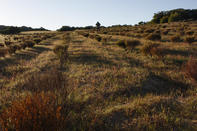Drought Resistant
Rhoda Malgas and her colleague Noel Oettle with the Nieuwoudtville-based NGO, Indigo Development and Change have been working extensively amongst communities in the Suid Bokkeveld and Wuppertal area to identify all the types of wild rooibos, which they are finding are better adapted to the tough environmental conditions than the commercial or maktee.

Tougher, more drought-resistant wild rooibos types are known to live up to 50 years and bounce back from long, dry spells with greater vigour than commercial plantings.
Since more research is being done on wild rooibos, alongside local communities, Malgas and Oettle have identified distinctive region-specific wild rooibos types in the Suid Bokkeveld plateau and the northern Cederberg, each of which carries the name given it by the locals.
There’s the rankies tea which grows around Wupperthal in stony, mountainous areas. It’s a low-yield plant, grows close to the ground and in places overlaps with another type, the langbeen (“long legged”) tea.
Conflict with Commercial Growers
Bossie tea (“bush” tea) grows in the Suid Bokkeveld, mostly in the sandstone areas. It grows into a large, wide, thick bush. The tall, upright rooibos used by communities around Heuningvlei, Langkloof, Vaalheuning near Wupperthal and the Agter Pakhuis area is called the langbeen rooibos and is a prolific plant.
The “tree type” is also tall and upright, say Malgas and Oettle, with a single trunk, and might grow as high as to a person’s chest. They’ve found this type around Kleinvlei near Wupperthal, Lokenburg in the Suid Bokkeveld and near a youth camp at Biedouw. There’s a simmering conflict here, though – as commercial rooibos plantations expand to meet the growing international demand, so the footprint of the crop stretches deeper and deeper into the veld.
The same veld where the wild tea occurs naturally. As the commercial interests expand, they are wiping out the habitat and individual wild rooibos plants whose genetic blueprint might one day mean the very survival of the industry as a hotter, drier climate continues to grip the province. It’s somewhat ironic that the success of the poor man’s tea, some of which now scoops a premium Euro for its novelty factor, could be the very thing that helps conserve the entire rooibos gene pool.
By Leonie Joubert